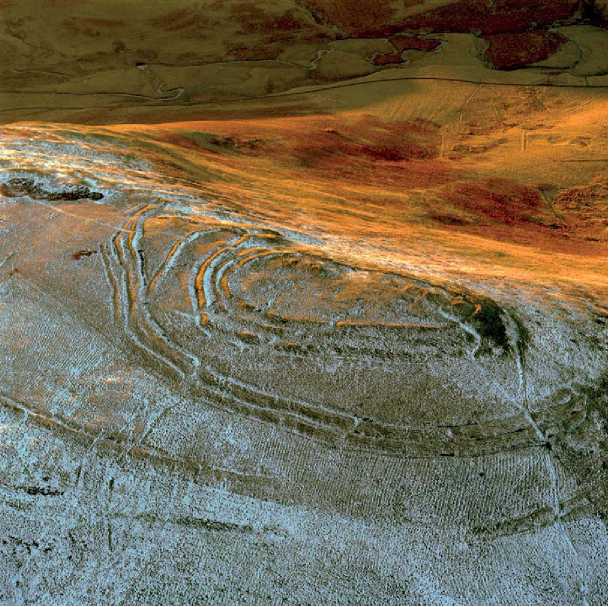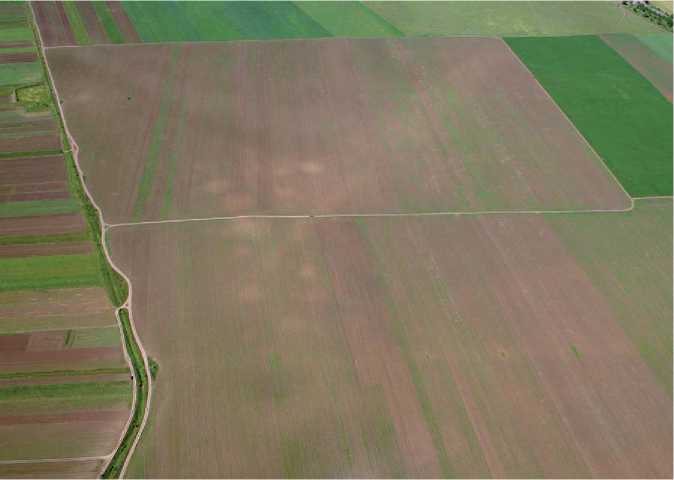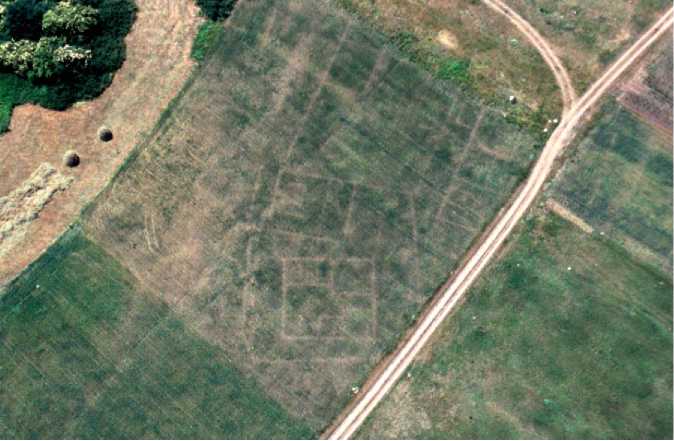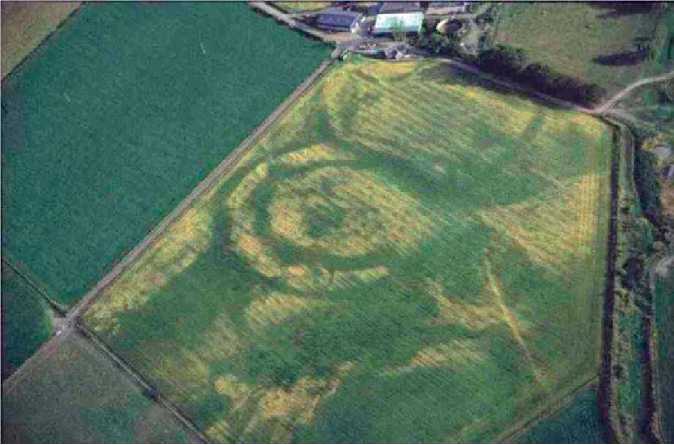The earliest applications focused on extant sites, whose outlines were more readily appreciated from an aerial perspective, though it rapidly became apparent that sites could be revealed in a number of ways.
Where sites are extant, even if so little survives above ground level that they are not readily appreciated from the ground, they may be revealed from the air by virtue of the pattern created by the shadows cast in low sunlight, producing what are known as shadow sites. This effect can be enhanced by a light covering of snow resulting in differential drifting or thawing (Figure 1), or emphasized by slight differences in texture or vegetation cover.
Sites may also be revealed in bare soil where any differential surface topography has been removed by years of ploughing. These soilmarks reflect the presence of buried archaeological sites through differences in soil color, temperature or water retention, or through different materials transported to the surface. They are best revealed in shallow soils where there is a strong color contrast between the subsoil and topsoil (Figure 2), but may disappear as the ploughing regime stabilizes. Variations in the Concentration of stone on the surface may reveal buried foundations, as in the famous examples of Roman villas and temples photographed in northeastern France by R. Agache. More ephemeral marks can occur simply as differences in moisture content caused by buried archaeological features which affect the spectral reflectance of the soil above them. This variation in moisture content can also result in sites being revealed by differential thawing in some areas of continental Europe, as demonstrated by O. Braasch.
By far the most important method by which buried sites are revealed from the air is as cropmarks, differential growth in agricultural crops. Water is essential to plant growth, both in its own right and as the means by which minerals are carried up from the roots. When moisture loss through evapotranspiration of the growing crop exceeds rainfall, a potential soil moisture deficit (SMD) is established which in a dry summer can build up over time. Once the growing plants have exhausted the water stored in their rooting zone, they begin to suffer moisture stress and to wilt. Plants growing over buried stone foundations or road surfaces will have a more restricted rooting zone and exhibit signs of moisture stress before other plants in the same field. Their growth will be less tall and luxuriant and they will ripen more quickly, creating what are referred to as negative cropmarks outlining the archaeological structure (Figures 3 and 4). The opposite occurs where plants are growing over buried pits or ditches, producing positive cropmarks, that is areas of relatively enhanced crop growth (Figures 4 and 5). The quantity and quality of crop-mark production depends largely on weather factors.

Figure 1 Shadow site enhanced by a light covering of snow of an Iron Age hillfort, linear earthworks, and prehistoric plowing at Woden Law, Scotland. Crown copyright: Royal Commission on the Ancient and Historical Monuments of Scotland.

Figure 2 Soilmark of burial mounds and Roman road, Vanatori, Romania. Copyright: I. A. Oltean and W. S. Hanson.

Figure 3 Negative cropmarks of stone buildings within the settlement outside the Roman fort at Cigmau, Romania. Copyright: W. S. Hanson.
Positive cropmark


Figure 5 Positive cropmarks of two adjacent later prehistoric ditched enclosures at Burnfoot, Scotland. Copyright: W. S. Hanson.
A consistently dry summer will generate good crop-mark recovery, but there are many localized variations associated with microclimates, soil variations, and different types of crop. Best results are obtained from deep-rooted crops, such as cereals, though in very dry summers marks can be obtained from shallow-rooted grass, usually referred to as parchmarks. It is possible to predict cropmark recovery to some extent on the basis of SMD figures in areas where these are produced for the farming community. Figures in excess of 100 mm are generally required before cropmarks become apparent (see Soils and Archaeology).




 World History
World History




![United States Army in WWII - Europe - The Ardennes Battle of the Bulge [Illustrated Edition]](https://www.worldhistory.biz/uploads/posts/2015-05/1432563079_1428528748_0034497d_medium.jpeg)




